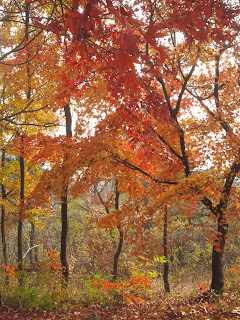Seoul contains five grand palaces that have existed during centuries of Korea's tumultuous history. This country has been invaded and held by outside parties so many times. No wonder everyone is polite and patient - they've had to be!
We don't have time to see all the palaces open to the public, so we chose the one that seems the most interesting and that's recommended over all the others, Changdeokgung. It is a truly Imperial palace, where the royal family lived and presided, even down to accomodation, albeit plainly decorated, for the king's concubine. It was the favoured palace of many kings of the Joseon Dynasty and in accordance with the Three Kingdoms of Korea period, its buildings blend harmoniously with the natural landscape.
Tickets are timed, so between purchase and entry we wandered aroudn the area, which is one of the last containing traditional Korean 'hanok' architecture. I find it interesting that a society that revers old things (including people) has no such reverence for old buildings and if it wasn't for tourists I imagine this neighbourhood would have be replaced by fall buildings by now. buildings in general are rasied, then demolished and replaced at larming speed.
.JPG) |
| What a lot of Seoul must have looked like last century |
.JPG) |
| lots of steep stairs in this part of Seoul! |
And it is peaceful. Entering the palace takes the visitor to another time. Each large building is set prominently in its separate location, each housing a separate function, with smaller buidlings attached and acting as separate rooms. Decoration is exuberant and colourful, with replaced sections made to look as they were originally. And there have been many replaced sections. This place has seen more than one fire, and of course more than one occupation. It was burned to the ground in 1592 by the Japances invasion and particularly impacted by the occupation of 1910-45, with most of the infrastructure destroyed and rebuild since.
.JPG) |
| intricate carvings and designs decorate the eaves |
.JPG) |
| Imagine painting these ceilings! |
.JPG) |
| Plainer style for the concubine's abode, which I actually prefer! |
One of the key drawsto this particular palace is the secret garden, or forbidden garden, so called because only the king may enter or those with his permission. It's a beautiful mix of water, forest, and pavilions mixed sensitively to the landscape itself. There are over 26,000 trees, with over 100 species represented. soem of the trees themselves are over 300 years old, their branches propped like an old man with canes.
It was lovely in the last days of autumn, with a hint of the brilliance it must have been a few weeks ago.
.JPG)
.JPG)
.JPG)
.JPG)
.JPG)
.JPG)
.JPG)
.JPG)
.JPG)
.JPG)

.JPG)
.JPG)
.JPG)
No comments:
Post a Comment